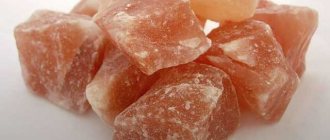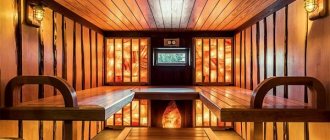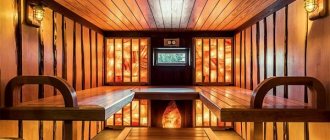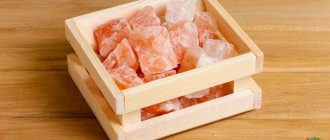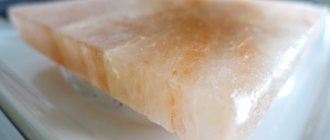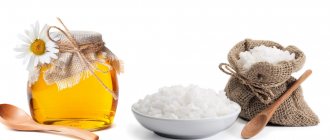What is a salt lamp or salt lamp?
It turns out that not all people still know about this lamp. Some are even sure that this is an ordinary decorative night light of a bizarre shape, nothing more.
How right or wrong they are, let's find out in this article.
Let's look at the real health benefits of this device, and along the way we'll debunk all the common myths and misconceptions, using not faith and user reviews, but scientific knowledge and laboratory instruments.
What is a salt lamp made of?
As the name suggests, the main component of this lamp is salt.
A traditional salt lamp consists of a large solid crystal of salt that acts as a lampshade. It can be of different shapes, volumes and weights.
The price most often depends on the weight (kg). Lamps 2-3kg are sold at one price, 5-6kg at another, etc.
Unless, of course, these are exclusive models with a bizarre shape.
A single piece of such material is scientifically called halite (rock salt). It contains sodium chloride and a small amount (as a percentage) of impurities and minerals.
The surface of the lamp can be either smooth or corrugated, which shows the original structure of the salt. Smooth is less useful, as it is capable of releasing less salt into the surrounding space.
Rough particles evaporate much better.
According to the manufacturers, they use rare Himalayan salt for the original lamps! We’ll tell you how true this is and how to verify this statement a little later.
Inside the lampshade, a hole is drilled from a piece of salt for a light bulb, not LED, but incandescent (usually 15W).
These are used for refrigerators or sewing machines.
Halogen lights can also be used.
These light bulbs are absolutely beasts in terms of generating heat in a confined space. You can even assemble a small stove using one halogen lamp.
The light bulb itself is fixed together with the socket and wires on a neat stand.
You simply place the drilled piece of crystal on top of the stand and plug the whole thing into a power outlet.
The color of the glow depends on the composition and structure of the salt. Most often it is a warming, red-orange hue.
As you can see, the device is simple. Moreover, don’t expect any real room lighting from it.
FAQ
Is it possible to cover an electric stove with pink salt tiles?
It is strictly not recommended to do this. Wood-burning and electric stoves are susceptible to salt vapor settling on the elements, resulting in plaque formation. As a result, short circuits, corrosion, and damage to the housing may occur. There are no such problems with stone stoves.
What is the weight of salt blocks?
Weight depends on size. Approximately 2 kg per brick 20 by 20 cm, about 2.5 cm thick.
I want to install lighting behind the salt tiles. Is it possible?
Yes, this method of use is acceptable. The diffused light of the diode strip looks especially beautiful through the prism of salt. Meanwhile, the wire elements must remain accessible; they cannot be completely walled up.
What is the best way to decorate a salt brick wall?
Alternating blocks of different shades looks advantageous. Volume and glow are created.
Is there a special glue for salt materials?
You can find such compositions in professional stores. They are harmless, durable, but very expensive (about 1000 rubles for 2 kg of dry mixture). It provides excellent adhesion to wood, concrete, plaster, brick and even plywood. The composition is prepared in portions, since it dries in no more than 20 minutes.
What other methods of installing salt bricks exist?
In addition to gluing, installation on guides is acceptable. The blocks are attached to stainless steel profiles or other metal frames. But for maximum strength, glue is also needed here.
Is it possible to line a bathhouse with salt tiles in winter?
This process is very risky. It is better to choose dry, warm weather with above-zero temperatures so that the glue sets well and the room can be ventilated from excess fumes.
Himalayan salt is a storehouse of benefits when used in a bath. With its help you can maintain beauty and health. The properties of the mineral are widely used in alternative medicine, especially by Ayurvedic doctors. In addition, salt products can decorate the interior of a steam room, which will make your vacation even more enjoyable.
Health benefits of a salt lamp
What is the use of this lamp and where does all the hype around it come from?
Any incandescent light bulb during its operation produces a large amount of heat (much more than light).
So, by putting such a lamp inside the salt lamp, you thereby heat the salt crystals.
The warm-up time for an average-sized lamp to reach optimal operation is 40 minutes. With regular use, be prepared for the bulb to burn out frequently.
No light bulb likes to overheat, but being locked inside such a thing there is no escape from it.
When salt crystals are heated, they begin to emit negative ions around them. Why does this happen?
Moisture molecules in the air land on the surface of the heated lampshade and release chloride ions from the crystal lattice.
Along with the ions, tiny particles of the salt itself also enter the air.
Thus, for the salt lamp to start working, the light bulb inside it must light up. When turned off, the lamp does not bring any benefit.
Well, unless you put it on the battery
